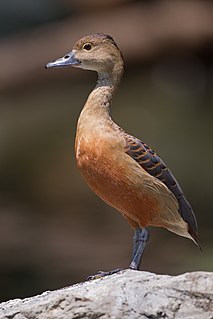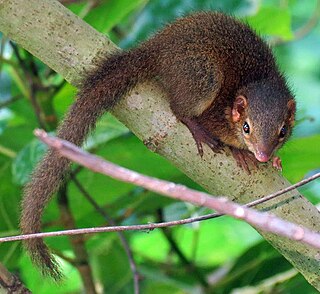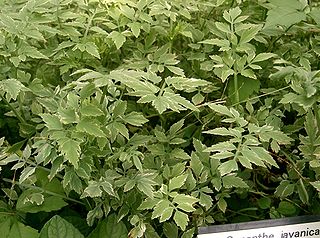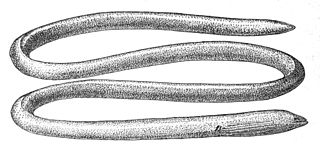
The lesser whistling duck, also known as Indian whistling duck or lesser whistling teal, is a species of whistling duck that breeds in the Indian subcontinent and Southeast Asia. They are nocturnal feeders that during the day may be found in flocks around lakes and wet paddy fields. They can perch on trees and sometimes build their nest in the hollow of a tree. This brown and long-necked duck has broad wings that are visible in flight and produces a loud two-note wheezy call. It has a chestnut rump, differentiating it from its larger relative, the fulvous whistling duck, which has a creamy white rump.

Meloidogyne javanica is a species of plant-pathogenic nematodes. It is one of the tropical root-knot nematodes and a major agricultural pest in many countries. It has many hosts. Meloidogyne javanica reproduces by obligatory mitotic parthenogenesis (apomixis).

Horsfield's treeshrew, also called Javan treeshrew, is a treeshrew species within the Tupaiidae. It is endemic to the Indonesian islands of Sumatra, Bali, Java and Nias where it inhabits foremost primary forest.

Aerva javanica, the kapok bush or desert cotton, is a species of plant in the family Amaranthaceae. It has a native distribution incorporating much of Africa, and the south-west and south of Asia, and it has become adventitious in northern Australia.

Japonica rice, sometimes called sinica rice, is one of the two major domestic types of Asian rice varieties. Japonica rice is extensively cultivated and consumed in East Asia, whereas in most other regions indica rice is the dominant type of rice. Japonica rice originated from Central China, where it was first domesticated along the Yangtze River basin approximately 9,500 to 6,000 years ago.

Oenanthe javanica, commonly Java waterdropwort, water celery, water dropwort,,Korean minari, Chinese celery, and Japanese parsley, is a plant of the genus Oenanthe originating from East Asia. It has a widespread native distribution in temperate Asia and tropical Asia, and is also native to Queensland, Australia.

Sambucus javanica, the Chinese elder, is a species of elderberry in the family Adoxaceae native to subtropical and tropical Asia. It is found naturally in Bhutan, Burma, Cambodia, China, India, Indonesia, Japan, Laos, Malaysia, the Philippines, southern Thailand, and Vietnam. It is a perennial herb or a small shrub 1–2 m tall.

Cassia javanica, also known as Java cassia, pink shower, apple blossom tree and rainbow shower tree, is a species of tree in the family Fabaceae. Its origin is in Southeast Asia, but it has been extensively grown in tropical areas worldwide as a garden tree owing to its beautiful crimson and pink flower bunches.

The Java spaghetti eel, also known as the Java thrush-eel, Java worm eel, and the black-tailed thrush eel is an eel in the family Moringuidae. It was described by Johann Jakob Kaup in 1856, originally under the genus Aphthalmichthys. It is a tropical, marine eel which is known from the Indo-Pacific, including East Africa, the Tuamoto Islands, the Ryukyu Islands, and Micronesia. It is a burrowing species which inhabits reefs at a depth range of 2–15 m. Males can reach a maximum total length of 120 cm.

Falsomesosella is a genus of longhorn beetles of the subfamily Lamiinae, containing the following species:

Brucea javanica is a shrub in the family Simaroubaceae. The specific epithet javanica is from the Latin, meaning "of Java". Other common names in English include Java brucea and kosam.
Castanopsis javanica, the Javan chestnut-oak, is a tree in the beech family Fagaceae. The specific epithet javanica is from the Latin, meaning "of Java".
Falsomesosella densepunctata is a species of beetle in the family Cerambycidae. It was described by Stephan von Breuning in 1968, originally under the genus Gyarancita. It is known from Laos.
Falsomesosella unicolor is a species of beetle in the family Cerambycidae. It was described by Stephan von Breuning in 1969.
Falsomesosella albofasciata is a species of beetle in the family Cerambycidae. It was described by Maurice Pic in 1925.
Falsomesosella nigronotata is a species of beetle in the family Cerambycidae. It was described by Maurice Pic in 1930.
Falsomesosella robusta is a species of beetle in the family Cerambycidae. It was described by Maurice Pic in 1944.
Falsomesosella grisella is a species of beetle in the family Cerambycidae. It was described by White in 1858. It is known from Taiwan.
Falsomesosella horishana is a species of beetle in the family Cerambycidae. It was described by Gressitt in 1938.

Cupang is a barangay in the Muntinlupa, Philippines. The total land area of the barangay is 5.370 km2. It has a population of 57,013. It is located in the Northern section of the city.











